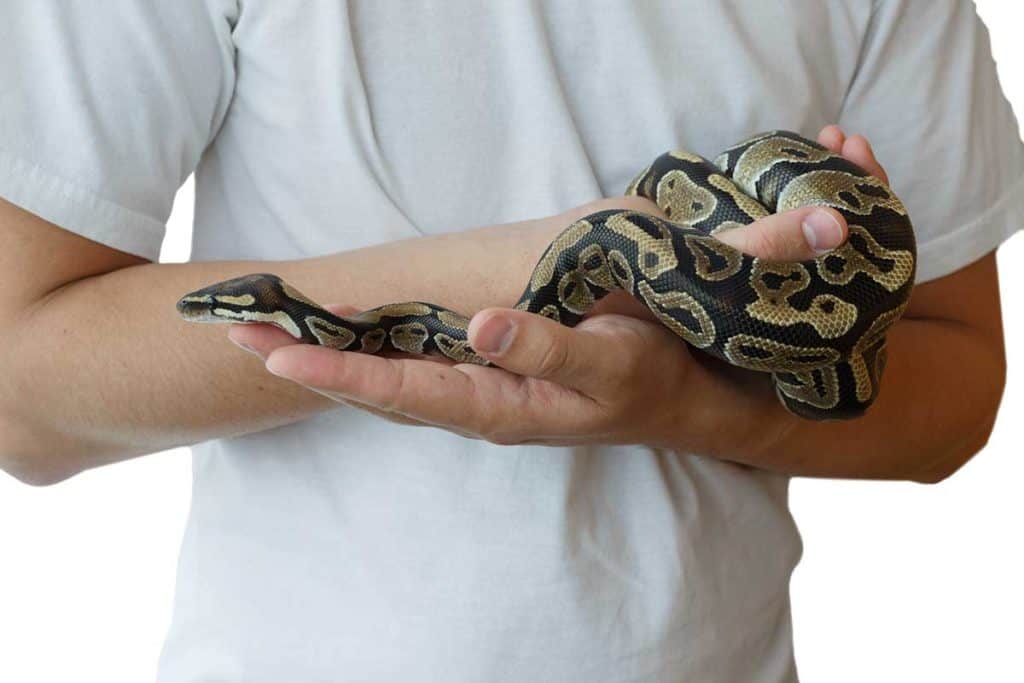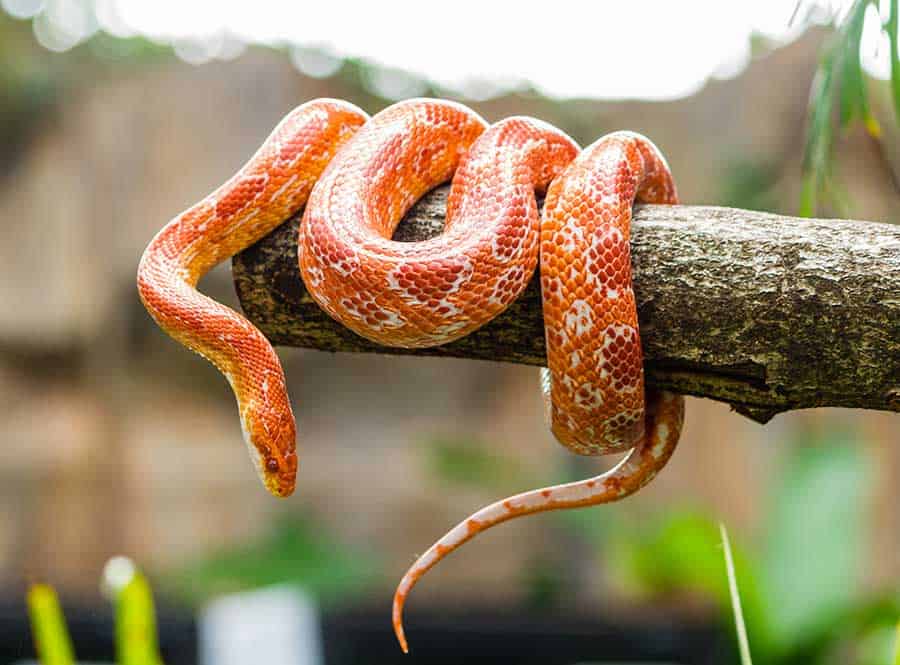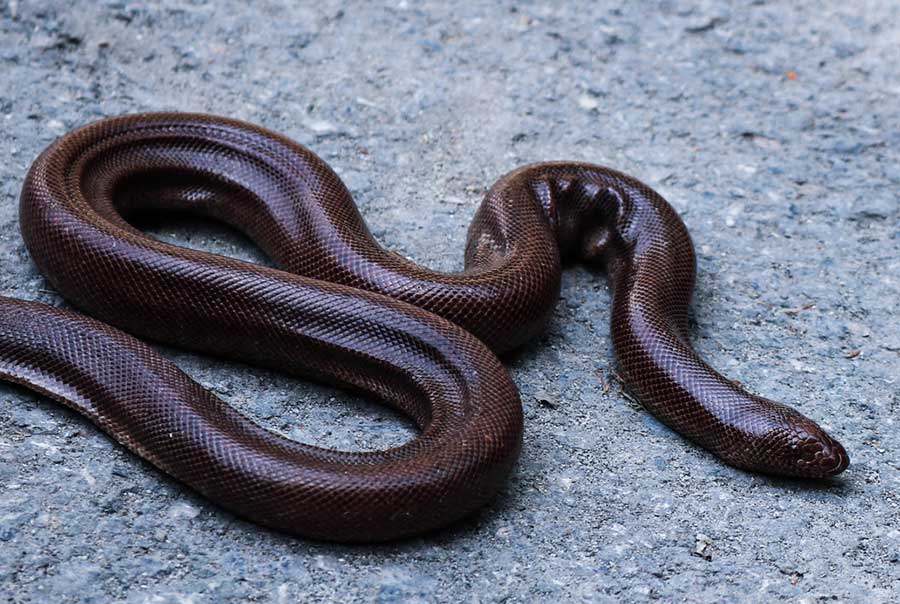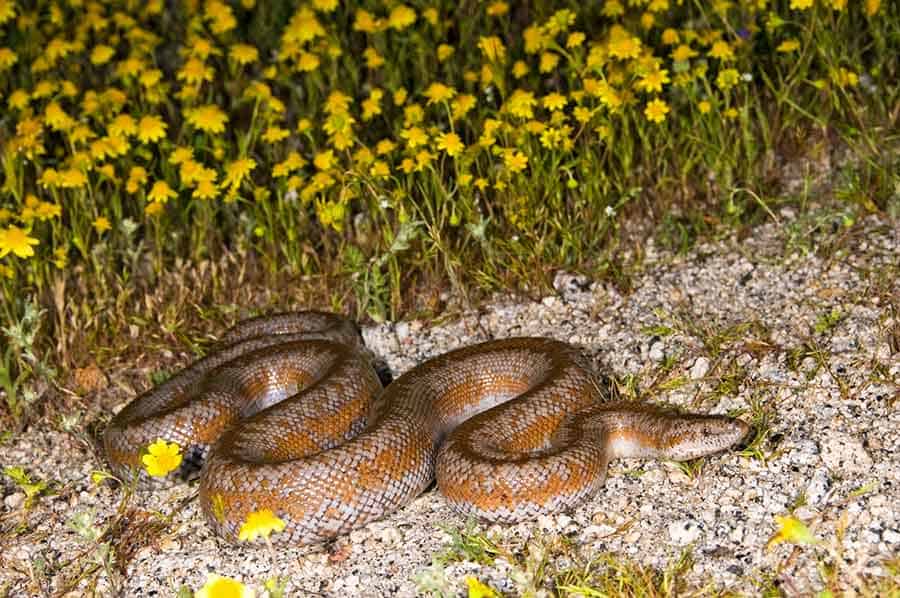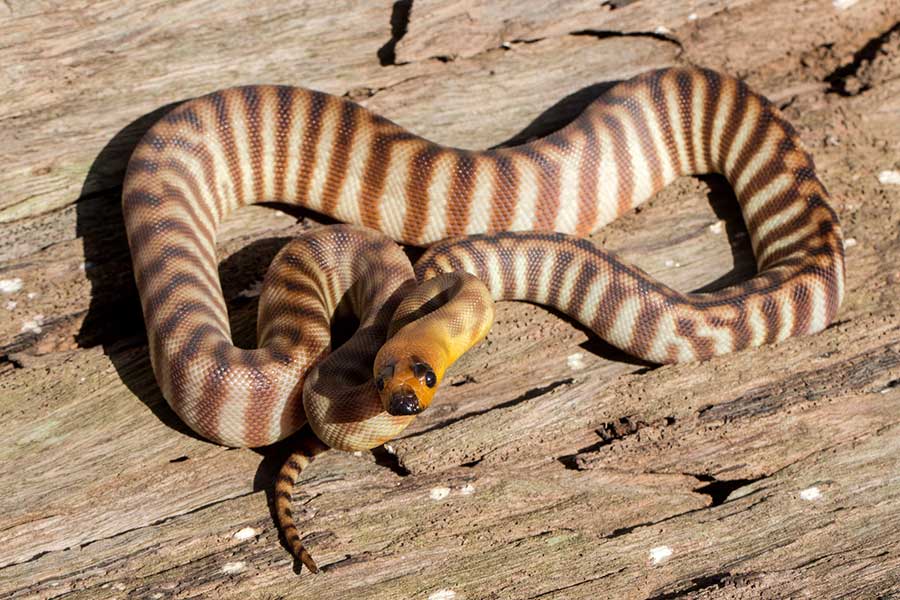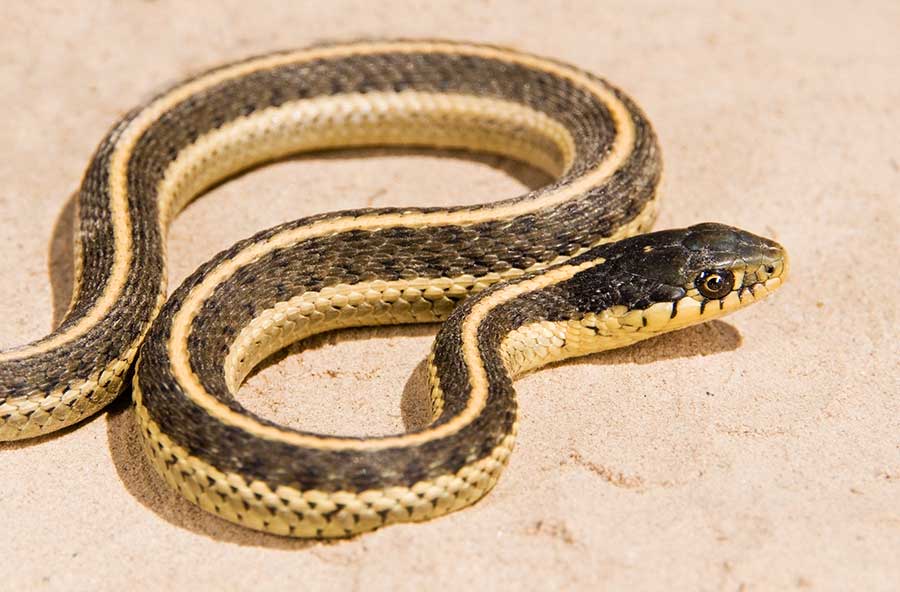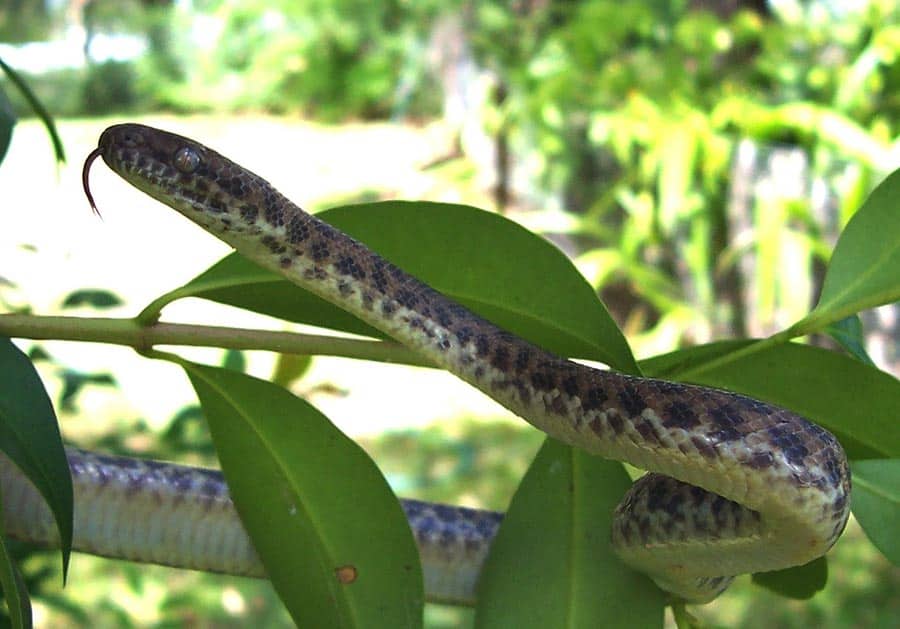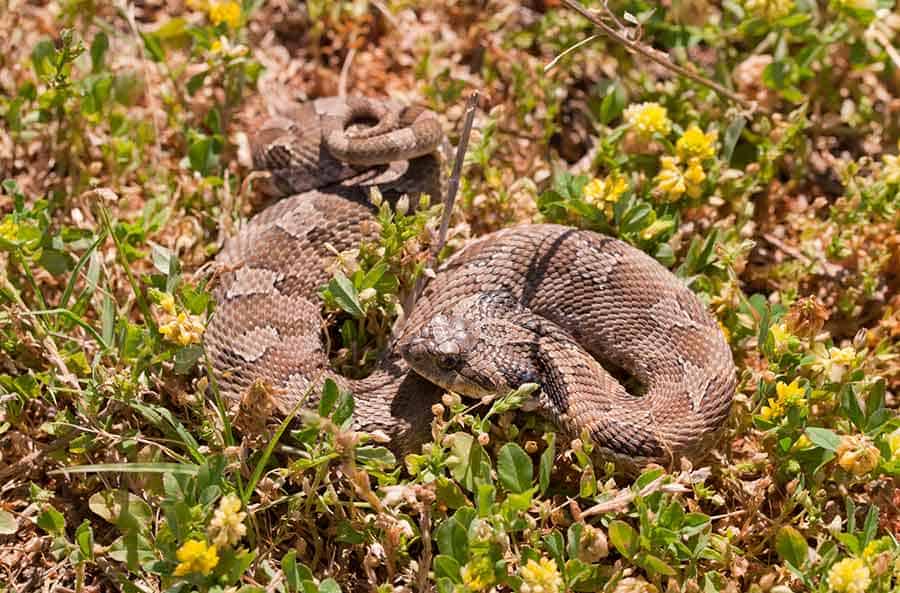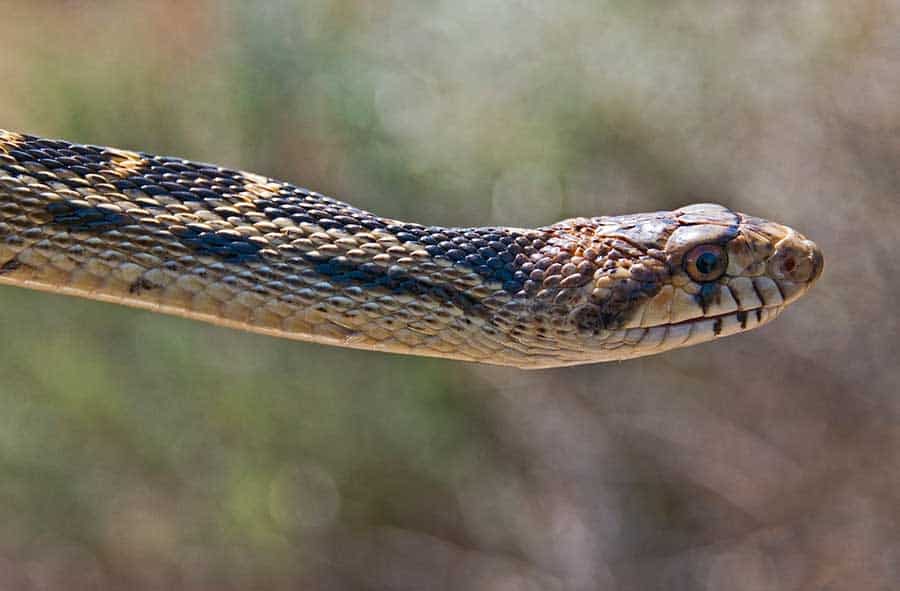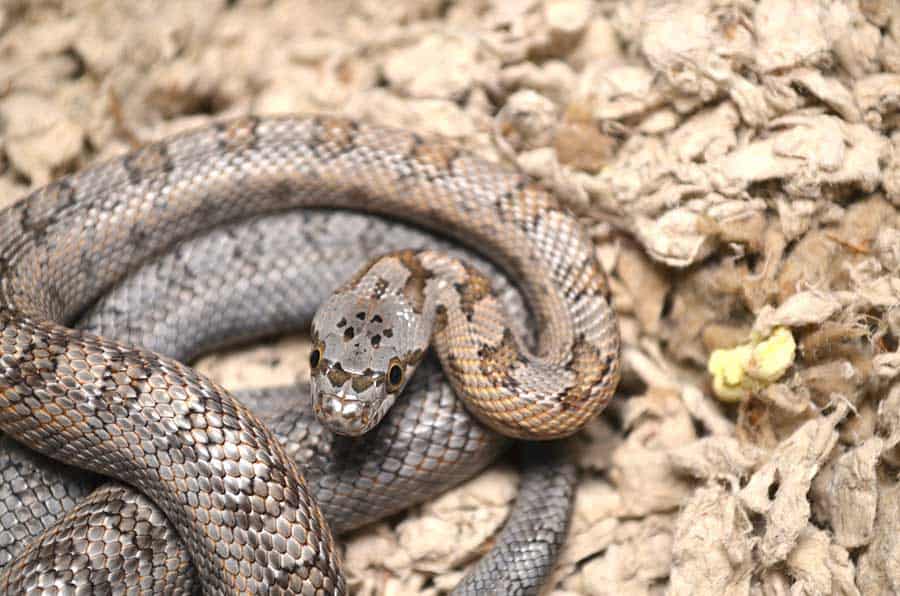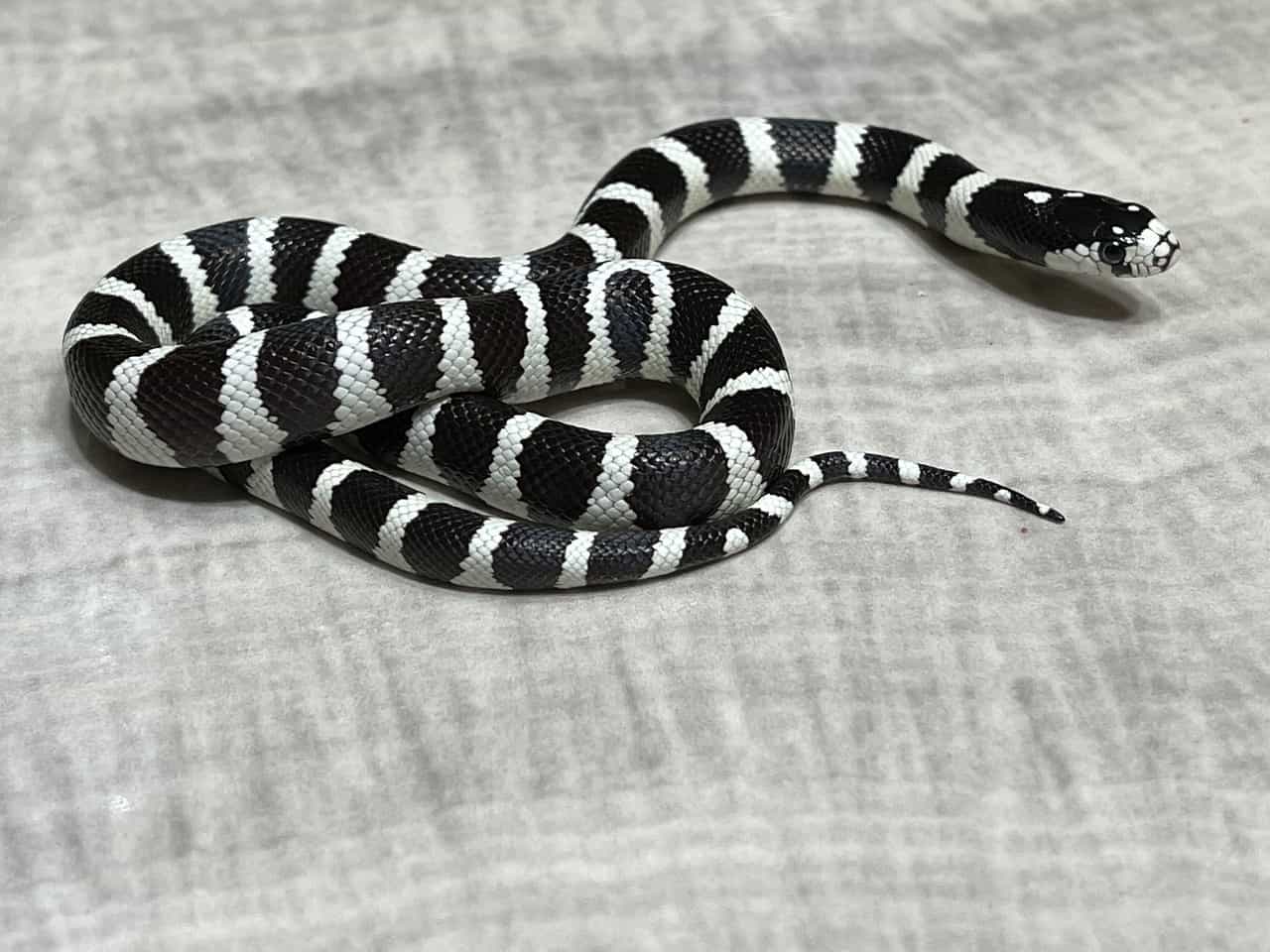While snakes can seem scary to some, they actually make great pets for adults and children alike! Read on to learn about the best pet snakes for beginners.
While dogs and cats make great household pets, a reptile might be a better fit for your lifestyle if you are looking for a pet that is relatively low maintenance. They don’t require daily walks or feeding like dogs do, yet they still enjoy time out of their cage when given the chance.
Though they’re often overlooked as first-time reptiles, snakes can make wonderful pets and there are several species out there that are ideal for beginners.
Choosing the best pet snake for you takes some time and research, as they all have slightly different care requirements. You need to make sure that the snake can fit in with your lifestyle and you can provide it with the best care. It’s important to consider their temperament, caging requirements, and overall husbandry needs. That way, you’ll have an idea of what you’re getting into and will be well prepared before bringing your new pet home.
All snakes are carnivores, which means if you own a snake, you need to be comfortable with feeding it mice or rat pinkies. You should always feed them frozen/thawed animals and never live ones, as live animals can stress out or even injure your snake in the feeding process.
This list was compiled with beginners in mind, and it offers a range of snakes who love to be handled, eat well, and live long lives.
The Best Pet Snakes
This table is a brief overview of the snakes that this article will discuss in detail. The snakes are organized from the easiest to the most difficult to take care of relative to each other.
1. Corn Snake
Quick Facts
- Length: Up to 6 feet
- Lifespan: 15 to 20 years
- Enclosure: 30 to 40 gallons
- Venomous: non-venomous
Corn snakes are by far the most common and popular snakes in the pet trade. They are easy to take care of and are pretty hardy when it comes to beginner care mistakes.
Captive-bred corn snakes are one of the most common pet snakes. Thanks to this, there is no shortage of reputable breeders to get your new scaly friend from! You can find them in a huge range of colors and patterns, so there is a wide variety to choose from if you go with this type of snake.
That being said, due to their widespread popularity, there are a lot of unwanted corn snakes that have been surrendered to rescues or listed in local classifieds. If possible, a great option is to adopt your new pet corn snake from a rescue. Not only will you be improving its life, but adoption can also be a more budget-friendly option than purchasing from a pet store!
Corn snakes are great for handling, as they are fairly docile and take well to being touched. This makes them excellent snakes for someone who is wanting to get comfortable with holding snakes.
They need a 30 to 40-gallon enclosure that is wider than it is tall. Some people say that 20 gallons is enough; however, corn snakes are very active, and the bigger the enclosure, the happier and healthier your pet will be.
Native to the southeastern United States and Mexico, they thrive best in ranges in temperature from about 75 to 82 degrees Fahrenheit. They also require a basking zone that is roughly 90 degrees. To give them this environment, you need an under tank heater as well as a basking lamp.
Corn snakes like to burrow under their substrate, so make sure they have at least 4 inches of loose substrate to burrow under.
2. Brown House Snake
Quick Facts
- Length: 1 to 3 feet
- Lifespan: 20 years
- Enclosure: 20 gallons
- Venomous: non-venomous
Brown house snakes, also known as African house snakes, are very common snakes to see in the garden and in your home. They are often looked over because they do not have the flashy coloring of a ball python or rosy boa.
However, they make incredible pet snakes for beginners. They are incredibly hardy and very forgiving of mistakes beginners make in their care. Even if they get a little sick, they will usually bounce back well once their care is rectified.
What is really nice about brown house snakes is that they stay relatively small. The males only get to approximately 1.5 feet, and the females max out at 3 feet at the most. This makes handling them a dream!
Brown house snakes are nocturnal snakes, which means they are most active at night. Most of their handling should be done in the evenings or at night when they are awake and moving around.
They are lovely to watch as they explore their environment because they are active and curious animals.
Brown house snakes need a thermogradient of 72°F to 80°F with a basking spot of 90°F. They need moderate humidity at 40 to 60%.
The big downside to these snakes is finding them! They are not very common in the pet trade, and so finding a good breeder with healthy brown house snakes can be difficult and take time. Be patient in your search for them, because they are definitely worth it!
3. Ball Python
Quick Facts
- Length: 3 to 5 feet
- Lifespan: 30+ years
- Enclosure: 30 to 40 gallons
- Venomous: non-venomous
Ball pythons are one of the most popular species of snakes in the pet world. They are relatively hardy, docile, and come in a wide variety of patterns and colors, or “morphs,” to choose from. Because of how popular they are, they are readily available and you should have no problem finding one you love!
They get their name from the way they roll themselves up into a ball as a defensive mechanism.
Though they look somewhat intimidating compared to some other beginner snakes, aggressive behavior is rare. They don’t tend to bite, which makes them a great choice of pet snake for a beginner. Males typically grow to a maximum of three or four feet, while females may reach lengths that are closer to five feet.
With this in mind, a ball python may not be the right fit for you if you are looking for a small snake that a kid can easily handle. However, they do have a long lifespan so they have the potential to be a member of your family for a long time. In captivity, they typically live to be between 15 and 30 years old!
Ball pythons may start out as pretty shy. As their owner, you need to spend serious time socializing them, getting to know them, and building their trust. Eventually, your ball python will come to trust you, and you will both have a very long and very happy life together.
Ball pythons are nocturnal snakes who like their privacy. This means if you want to watch it move around its enclosure freely, you need to do it at night when it does not think anyone is watching.
4. Rosy Boa
Quick Facts
- Length: Up to 4 feet
- Lifespan: 25+ years
- Enclosure: 20 to 30 gallons
- Venomous: non-venomous
If you’re slightly nervous about the idea of handling your new pet snake, then a rosy boa might be just the right choice for you.
Boas are not typically considered beginner reptiles. However, rosy boas have a reputation for being docile and are much smaller than other boas. These boas only grow to a maximum of 4 feet in length, so there is no worry of them seriously hurting you like a boa constrictor (BCI) would.
They have a calm temperament, tolerate handling well, and are more lazy and slow-moving than other snakes. This makes them ideal if you have a child who isn’t used to handling reptiles and also means there is less risk of losing your snake if they fall from your hands.
Rosy boas have beautiful stripes down their bodies that really set them apart and make them lovely to watch as they move around in their enclosures.
They love to eat and will eat so long as you provide them with food! This can be a problem, since because their prey drive is so high, they may mistake your fingers for a mouse and nip you if you aren’t careful during feeding time. This snake also typically struggles with obesity because they are such good feeders.
Rosy boas have similar care requirements as corn snakes. Though they have started becoming more popular in recent years, they can still be more difficult to find than other beginner snakes, so the best place to purchase one is typically a local reptile expo near you.
The only really tricky care requirement of rosy boas is their humidity levels. They need very low humidity. If the humidity cimbs even a little bit, they will develop a respiratory infection and die.
The humidity needs to be so low that you should not leave a water dish in their enclosure. Instead, you need to place a water dish in their enclosure for a couple of hours at a time three times a week so they can drink their fill, and then remove the dish immediately afterward.
5. Woma Python
Quick Facts
- Length: 4 to 6 feet
- Lifespan: 20 years
- Enclosure: 40 gallons
- Venomous: non-venomous
Woma pythons come from Australia and are very popular in the pet trade. Woma pythons are very docile and take well to frequent handling. They are also a decent size, which makes handling them easier because a beginner handler is less likely to feel like they will hurt them.
These snakes need a minimum of a 40-gallon enclosure because they are active and constantly exploring their surroundings. This means you can have a lot of fun putting up decorations like rocks, branches, hammocks, and more for your Woma python to explore and hang out on.
Woma pythons need a thermogradient of 79°F to 85°F with a basking spot of 90°F. Using an under tank heating pad is a good way to achieve an even temperature gradient. Supplement the heating pad with a basking lamp so your snake has the right temperature no matter where it goes in its enclosure.
Woma pythons are also excellent eaters! They are such good eaters that they will take food even if they are full! Make sure you do not overfeed them, as obesity is a serious health risk to Womas.
6. Garter Snake
Quick Facts
- Length: 2 to 4 feet
- Lifespan: 5 to 10 years
- Enclosure: 30 gallons
- Venomous: rear-fanged
Garter snakes are often overlooked in the pet trade simply because they are common garden snakes! In fact, the garter snake is the most common snake in the entire world!
Garter snakes are incredibly active and always moving around. This makes them exciting to watch and fun to handle and interact with. Males are much smaller than females and max out at 2 feet and are very thin. Females on the other hand grow to be 3 feet and are twice as thick as the males.
One thing to keep in mind before purchasing a garter snake is that many of them are wild-caught. This means they were not bred in captivity and may not adjust well to socializing with humans. This isn’t an ideal situation for a beginner, but you can avoid it by purchasing a captive-bred baby instead.
Additionally, they do not enjoy being handled as much as other species, and their small size means they can easily slither out of your hands. When feeling threatened or spooked, they may secrete a foul-smelling musk from glands near the base of their tail.
A garter snake is an ideal first-time reptile for someone who has limited space. Unlike many other beginner snakes, this species is smaller and needs less room. To put things in perspective, while many popular snakes require at least a 40-gallon tank, garters only require 15 or 20 gallons of space.
Garter snakes are cool because they generally live in colonies in the wild, which means you can house multiple garter snakes together. Starting with a 30-gallon enclosure, for every snake you add to the enclosure, the enclosure needs to grow by 10 gallons. You also need to include extra hides and water dishes so they don’t compete for resources.
Always separate your snakes at feeding time to avoid them chomping each other by mistake!
Garter snakes are unique in that they can eat a varied diet! You can feed them rodents, feeder fish, and even juicy worms!
All things considered, garters are a great choice for beginners because of their easy care requirements, but they aren’t the best pet for someone who wants to have a lot of interaction. They also have a shorter lifespan in comparison to other species, living to roughly eight or 10 years in captivity.
7. Children’s Python
Quick Facts
- Length: 2 to 4 feet
- Lifespan: 15 to 25 years
- Enclosure: 30 to 40 gallons
- Venomous: non-venomous
Children’s python is named after the scientist, John George Children, who first described the snake in western science. If you are wanting to get a python but are worried the ball python is still too big for you, then the Children’s python is perfect!
Even though they are named Children’s python, they should not be handled or cared for by children if they are not being supervised. Children often tend to squeeze or drop snakes in excitement or fright, and this ends in bites and hurt snakes.
Children’s pythons love to climb around the upper areas of their enclosure as well as dwell on the ground. You need to include sturdy branches and perches so that they can climb around and get as much exercise as they want.
These pythons are nocturnal! This means they are mostly active at night. You should keep handling time to the evening or later at night when they are most comfortable being awake.
Because they are nocturnal, they should not have a direct light in their enclosure that stays on 24 hours a day. They need some daylight to help them regulate. However, their heat source should be an under tank heating pad or a ceramic heat emitter.
8. Hognose Snakes
Quick Facts
- Length: 2 to 3 feet
- Lifespan: 10 to 20 years
- Enclosure: 20 to 30 gallons
- Venomous: rear-fanged
Hognose snakes are possibly the cutest snakes to look at. Their little piggy noses that are turned up give them a perpetual dopey smile on their faces! These upturned noses are where their names come from.
Hognose snakes are rear-fanged venomous. This means they do have a small amount of venom that they use to hunt. Their fangs are in the back of their mouths. When they hunt, they strike out at prey, bite onto it, and have to chew it to work their venom out of their fangs.
This makes envenomating humans an almost unheard of experience. You would have to let the snake bite you and then chew on you for some time.
Also, when hognose snakes strike out at humans, they almost never open their mouths and instead try to look big and scary and basically “boop” you with their nose!
Males are much smaller than females and rarely get over 20 inches! Females will generally stay under three feet in length. This makes them very manageable. It also means they do not need a very large enclosure.
These unique snakes’ upturned noses are like that so they can breathe and scent prey while they are burrowed underneath sand. They need about three to four inches of substrate to burrow into. They will almost never climb vertically in their enclosure, so focus on making the floor of their home interesting and enriching.
9. Gopher Snake
Quick Facts
- Length: 3 to 6 feet
- Lifespan: 15 to 30 years
- Enclosure: 30 to 40 gallons
- Venomous: non-venomous
Gopher snakes are also known as bull snakes, can be mistaken for Pacific rattlesnakes. This is because their coloration is similar, and the gopher snake will shake its tail to imitate the rattle on a rattlesnake’s tail to ward off predators.
They are curious and active snakes. However, they do have a reputation for being less tolerable of handling than other species, so this may not be the best fit for you if you have a young kid or want to handle them often.
Many captive-breds are fine with being handled, so at the end of the day, it really just depends on the individual personality of the snake. If you pick them up and they aren’t enjoying it, they’ll let you know with their epiglottal keel, a special throat flap that vibrates.
Because they are larger than your typical beginner snake, gophers require a bigger enclosure. The minimum that’s typically recommended is a 48”L by 24”W enclosure. They are very active when given the necessary space, so bigger is better when it comes to this species. With that being said, these snakes can be super fun to watch as they explore their habitat.
Gopher snakes are incredibly hardy and will survive common beginner mistakes without taking serious damage.
They live to be roughly 15 years old in the wild. However, in captivity, they are known to get to 30 years! Just make sure you are ready for a long-term commitment when you are buying a gopher snake.
Some states have regulations and restrictions placed on gopher snakes, garter snakes, and hognose snakes, so double-check with your state’s laws before you purchase!
10. Baird’s Rat Snake
Quick Facts
- Length: 4 to 5 feet
- Lifespan: 8 to 12 years
- Enclosure: 30 to 40 gallons
- Venomous: non-venomous
Baird’s rat snake comes from the southwestern USA and northeastern Mexico. Their natural habitat is dry, semi-arid, and quite rocky. Like with any reptile, their enclosure should mimic their natural habitat as closely as possible.
Their wild diet is rats, rats, and more rats, which makes them excellent eaters that are easy and fairly inexpensive to feed. They will take food if you offer it even if they are full, though, so watch out for over feeding them, as obesity is a serious health concern with rat snakes.
Baird’s rat snakes are not as popular as Eastern rat snakes; however, they are much more colorful and fun to look at than their gray cousins! Baird’s rat snakes develop bright orange and yellow bellies as they mature.
Use about 4 inches of dry loose substrate in the enclosure so they can comfortably burrow underneath it for privacy.
If you use substrates that hold onto moisture like coconut coir, then the humidity in the enclosure will be too high, and your rat snake will run a high chance of contracting a respiratory illness. Humidity levels should always be between 40% and 50%.
Baird’s rat snakes need a thermogradient of 78°F to 90°F with a basking spot of 95°F. Having a basking spot is essential because this is where your snake will lay while they are digesting their food.
11. California Kingsnake
Quick Facts
- Length: 2.5 to 3.5 feet
- Lifespan: 20 years
- Enclosure: 40 to 50 gallons
- Venomous: non-venomous
For a beginner looking to adopt their first pet snake, a California kingsnake is a great option. They are popular and easy to care for. As an added plus, they are also relatively inexpensive.
These snakes come in over 50 different colorations, some of the most popular being the striped and banana morphs. True to its name, this snake is native to California and is called a “king” because it’s a predator of many venomous snakes. But though they are predators in the wild, they are generally docile with their human owners.
This species is excellent for beginners because of its friendly and sociable temperament. They sometimes tend to get over-excited at feeding time, though, so this might be a bit intimidating if you’re a new keeper and don’t have any prior experience with reptiles.
To make sure your California kingsnake has a high quality of life, you’ll want to get at least a 40-gallon tank and avoid overcrowding their enclosure since they like spending the majority of their time on the ground.
When given proper care, California kingsnakes will grow to be between three and four feet long as adults. Furthermore, they can live to ages of up to 20 or even 30 years, so that’s something to consider if this is a pet for an older child who may be moving away soon.
Snakes That Beginners Should Avoid
There are a number of snakes that beginners should avoid for a number of reasons. Some snakes have very particular care requirements that need experience to master, such as smooth and rough green snakes and dragon snakes.
Hot Snakes
Beginners should definitely avoid all ‘hot’ snakes. This means snakes that are (front-fanged) venomous. These snakes have the potential to kill their handlers, especially if the handler does not have enough experience to anticipate an attack.
Large Snakes
Very large snakes should also not be owned by beginners. Burmese pythons, boa constrictors, green and yellow anacondas, African rock pythons, and reticulated pythons all have the ability to severely harm and even kill inexperienced owners.
Water Snakes
Finally, water snakes should be avoided by all but the most experienced reptile owners. They are mostly venomous and have such specific care needs that it is almost impossible to keep them alive in captivity.
Snake Enclosure Essentials
Although all snakes’ care requirements are a bit different, there are a few essentials that most need in captivity to thrive. Keep these in mind:
- You need a
thermometer on the warm and cool side - You need a hygrometer to measure the humidity levels
- You need at least two hides per snake
- You need a water dish that is nonporous, heavy-bottomed, and large enough for your snake to soak in comfortably
Snakes as Pets
While snakes don’t interact with their owners the same way a dog or cat might, they can still make great pets for adults and children alike. While this can be frustrating to some, it also means they are relatively low-maintenance pets that are easy to care for.
Simply put, they don’t really bond or emotionally connect with humans and won’t get upset if you don’t interact with them every day. This makes them the perfect pet if you have a busy schedule or a lot of commitments outside of the home.
That being said, pet snakes generally will tolerate some interaction, and it can be a great form of enrichment to get them out of their cages every now and then. Even though they aren’t affectionate pets, you’ll still have more interaction than you would with, for example, a fish.
They also don’t need to be fed on a daily basis like other animals. Smaller and younger snakes might eat twice a week while adults typically eat every one or two weeks. Generally, snakes make good, easy pets if you’re okay with the fact that they won’t bond with you on an emotional level.
FAQs About Pet Snakes
What are the best pet snakes for kids?
All things considered, corn snakes are probably the best for kids. This is because they are considered one of the friendliest species of pet snakes out there.
Their docile nature means they are generally easier for children to interact with and tend to tolerate handling well once they recognize and begin to trust their owner.
Corn snakes are a very commonly kept type of snake, so they are readily available and easy to acquire. They are also quite hardy, which makes them a great first-time reptile for new keepers. If you’re getting a pet snake for your child and you want one they’ll be able to interact with, this species of snake is likely your best bet!
Another great option is a ball python. While these snakes can appear threatening, they are actually not really prone to aggressive behavior. It’s rare that you will be bitten by this type of snake, and they have relatively easy care requirements.
Which is better: corn snake or ball python?
For a beginner, the better of these two options is most definitely a corn snake. This is because they have simpler care requirements and there is less room for mistakes to be made by a new reptile keeper.
Since ball pythons are tropical snakes, they require a bit more patience when setting up an ideal
Corn snakes, on the other hand, are native the United States, so maintaining high humidity is not something you need to be concerned with.
Both species grow to roughly the same maximum length, between three and five feet long. However, keep in mind that ball pythons tend to be thicker snakes. Therefore, they will appear larger than corns and will be heavier when it comes to handling.
The downfall of corn snakes is their shorter lifespan. While ball pythons have an average lifespan between 15 and 30 years, corn snakes typically live between 15 and 25 years. While that’s still a long life, it’s definitely something you should consider when deciding between these two pet snakes.
Should I feed my snake frozen or live rodents?
You should always feed your snakes frozen/thawed animals and never live ones. This is for three reasons.
- Live rodents attack snakes and scratch and bite them in defense. This leads to injuries to your snake. Sometimes, these injuries are severe, such as dislocated jaws and blindness.
- Live rodents carry diseases and parasites. By going through the freezing process, these parasites and bacteria are killed off and cannot be passed on to your snake.
- Buying frozen rodents in bulk is much cheaper than trying to keep a pen full of rodents alive and bonding with them only to serve them to your snake as food.
How do I feed my snake frozen/thawed rodents safely?
It is very important to feed your snake properly, otherwise you put them at risk of dying. You should take the rodent out of the freezer the morning or night before you intend to feed your snake.
Place the rodent in a bowl of hot water and let it come to room temperature. Once it is at room temperature, feed it to your snake while it is still wet.
It is essential that the rodent is not still partially frozen or boiling hot. If they eat something that is still partially frozen, then their core body temperature will drop, and they could die.
Slithering Off…
Owning a snake and taking care of it properly is an incredibly rewarding experience. The best pet snakes are the ones that are healthy and happy in your care. If you are looking to own a snake, then we hope this list has given you some inspiration.
If snakes are not your thing, but you are looking for other reptiles for beginners, then check out our guides on the best lizards to own for beginners!
Taking care of snakes is not an easy task, even if they are labeled as “beginner” snakes. You still need to do a lot of research and speak to those who are more experienced than you. Reach out to reptile enthusiast forums for advice; experienced hobbyists are always happy to help!

